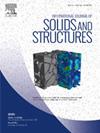Upscaling transformation plasticity using full field fast Fourier transform simulations of polycrystals undergoing phase transformations under applied loads
IF 3.4
3区 工程技术
Q1 MECHANICS
International Journal of Solids and Structures
Pub Date : 2025-03-25
DOI:10.1016/j.ijsolstr.2025.113337
引用次数: 0
Abstract
Transformation plasticity has been intensively studied because of its significant impact on various industrial fabrication and forming processes. The widely used analytical macroscopic models are based on idealized microstructures and strong assumptions. Such models predict linear (or weakly non-linear) dependence between the transformation plastic strain rate and the applied load, whereas experimental evidence shows that this dependence becomes highly non-linear when the applied stress becomes non-negligible with respect to the macroscopic yield stress. Such a non-linear response is not fully understood especially for phase transformations arising at high temperatures for which the product phase is often softer than the parent phase, and involving visco-plastic behavior.
Therefore to overcome this difficulty, the first key contribution of this paper is to exhibit the detailed mechanisms leading to transformation plasticity in steels undergoing austenite to ferrite phase transformation at high temperature and to explain the non-linear dependence between the transformation plastic strain and the applied load. To do so, full-field simulations of visco-plastic polycrystalline aggregates undergoing phase transformations under applied load are performed. In addition, the second key contribution consists in upscaling the outcomes obtained at the scale of the polycrystal into a macroscopic statistical model, that can be used for large simulations of industrial processes. To do so, a database of computations with various initial microstructures, grain shape distributions, and applied loads have been performed, and used to derive the macroscopic statistical model. Of course, to create such a database, a relatively short computation time should be obtained for the full-field simulations, which is achieved by using a fast Fourier transform-based algorithm.
Numerical results showed that the combination of two different mechanisms may explain the non-linear behavior of transformation plasticity with respect to the applied load. Moreover, the upscaled statistical model has been tested on full field simulations not included in the database and a good agreement was observed.
应用全场快速傅立叶变换模拟在外加载荷作用下发生相变的多晶体的相变塑性
由于变形塑性对各种工业制造和成型工艺有重大影响,因此对其进行了深入研究。广泛使用的宏观分析模型基于理想化的微观结构和强有力的假设。这些模型预测塑性变形应变率与外加载荷之间存在线性(或弱非线性)关系,而实验证据表明,当外加应力相对于宏观屈服应力变得不可忽略时,这种关系会变得高度非线性。因此,为了克服这一困难,本文的第一个主要贡献是展示在高温下发生奥氏体向铁素体相变的钢材中产生转变塑性的详细机制,并解释转变塑性应变与施加载荷之间的非线性关系。为此,我们对在外加载荷作用下发生相变的粘弹性多晶聚集体进行了全场模拟。此外,第二个主要贡献是将在多晶体尺度上获得的结果升级为宏观统计模型,该模型可用于工业过程的大型模拟。为此,我们利用各种初始微观结构、晶粒形状分布和应用载荷进行了计算,并建立了一个数据库,用于推导宏观统计模型。数值结果表明,两种不同机制的结合可以解释转化塑性与外加载荷的非线性行为。此外,还在数据库中未包含的全场模拟中测试了放大统计模型,并观察到了良好的一致性。
本文章由计算机程序翻译,如有差异,请以英文原文为准。
求助全文
约1分钟内获得全文
求助全文
来源期刊
CiteScore
6.70
自引率
8.30%
发文量
405
审稿时长
70 days
期刊介绍:
The International Journal of Solids and Structures has as its objective the publication and dissemination of original research in Mechanics of Solids and Structures as a field of Applied Science and Engineering. It fosters thus the exchange of ideas among workers in different parts of the world and also among workers who emphasize different aspects of the foundations and applications of the field.
Standing as it does at the cross-roads of Materials Science, Life Sciences, Mathematics, Physics and Engineering Design, the Mechanics of Solids and Structures is experiencing considerable growth as a result of recent technological advances. The Journal, by providing an international medium of communication, is encouraging this growth and is encompassing all aspects of the field from the more classical problems of structural analysis to mechanics of solids continually interacting with other media and including fracture, flow, wave propagation, heat transfer, thermal effects in solids, optimum design methods, model analysis, structural topology and numerical techniques. Interest extends to both inorganic and organic solids and structures.

 求助内容:
求助内容: 应助结果提醒方式:
应助结果提醒方式:


